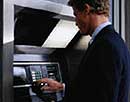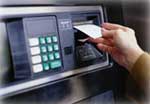Augmented technology manufacturing
By At a time when Indian ba | 11 Dec 2003
 Mumbai: Over the last couple of years, the Indian banking industry has come to the stark realisation that unless they upgrade technologically, they will perish. The reason for upgrading banking IT services is that IT services in banking, apart from offering faster and more efficient transactions, will help reduce the costs of transactions, the benefit of which can be passed on to the customer as well as the bank.
Mumbai: Over the last couple of years, the Indian banking industry has come to the stark realisation that unless they upgrade technologically, they will perish. The reason for upgrading banking IT services is that IT services in banking, apart from offering faster and more efficient transactions, will help reduce the costs of transactions, the benefit of which can be passed on to the customer as well as the bank.
Thus banks — private or public, small or big, and even urban cooperative banks — are upgrading their IT services like never before. Now, to provide some of the frontline IT services, NCR Corporation of the US has set up shop in India.
Last week, NCR Corporation India Pvt Ltd (NCR), the wholly owned subsidiary of NCR Corporation, set up a plant in Pondicherry for manufacturing automated teller machines (ATMs), the market for which is growing at the rate of 60 per cent per year.
![]() NCR, in collaboration with the Industrial Design Centre at the Indian Institute of Technology, Mumbai, has conceptualised, designed and developed a prototype of an ATM which is an 'India-specific' ATM. The main India-specific features are that these machines are tropicalised and can handle currency notes on which the dust content is relatively high as compared to the currency notes of other countries.
NCR, in collaboration with the Industrial Design Centre at the Indian Institute of Technology, Mumbai, has conceptualised, designed and developed a prototype of an ATM which is an 'India-specific' ATM. The main India-specific features are that these machines are tropicalised and can handle currency notes on which the dust content is relatively high as compared to the currency notes of other countries.
The ATMs also have an uninterrupted power supply facility and supports wireless connectivity, which will enable it to function in areas with poor conventional telecommunication infrastructure. ATMs are today available at a price range of Rs 6 lakh to Rs 9 lakh per unit. NCR's India-specific ATMs are priced at a wee bit below Rs 5 lakh per unit.
NCR's current capacity is pegged at 2,500 units per year but the company is bullish about its prospects and plans to increase the capacity to 10,000 units per year from 2005 onwards.
 NCR Corporation is planning to make India its hub for marketing and distribution in the Asia-Pacific region. And to meet an expected increase in demand from the region, the ATM maker will double the production of ATMs at its Pondicherry facility. Besides, NCR is also setting up an additional ATM plant in Bangalore that will have the capacity to produce 8,000 to 10,000 ATMs per year.
NCR Corporation is planning to make India its hub for marketing and distribution in the Asia-Pacific region. And to meet an expected increase in demand from the region, the ATM maker will double the production of ATMs at its Pondicherry facility. Besides, NCR is also setting up an additional ATM plant in Bangalore that will have the capacity to produce 8,000 to 10,000 ATMs per year.
The company intends to source over half of all ATM component costs locally. "At present, we make around 100 units per week and this will be doubled to meet an expected rise in demand in India," says NCR Corporation vice-president (global operations) David A Ramsay.
The company will also increase its global spend on research and development, a major chunk of which will be coming into India, even as NCR is scouting for places to set up additional facilities in the country. Presently, NCR is envisaging a spend of $ 6 billion for the Bangalore facility, which will also have a banking services and solutions centre.
The company expects a rise in demand as a large number of banking applications is installing ATMs, says Ramsay. "NCR will make India the manufacturing hub for all the countries in the Asia-Pacific region from India."
NCR is also planning to open more manufacturing units in India and is looking for suitable destinations, he adds. "An increase in R&D expenditure is required to meet the increased need for speed, accuracy and convenience of ATMs."
 According Las Nyberg, chairman and CEO, NCR Corporation, USA, NCR's commitment in India will see the company's existing workforce of 400 more than double to around 1,000 employees in the next 12-18 months. The company has an ATM channel management centre in Mumbai and this has the capacity to remotely manage over 6,000 ATMs across the country.
According Las Nyberg, chairman and CEO, NCR Corporation, USA, NCR's commitment in India will see the company's existing workforce of 400 more than double to around 1,000 employees in the next 12-18 months. The company has an ATM channel management centre in Mumbai and this has the capacity to remotely manage over 6,000 ATMs across the country.
Deepak Chandnani, managing director, NCR, is of the view that changing bank customer behaviour by getting them to use ATM and debit cards will see the industry grow. "Compared to China's 500 million or so debit cards, the population of the same in India is around 15-20 million. Unless customers are incentivised to use the ATM, banks will not realise the value of their investments in the same."
The boost given by the Reserve Bank of India to cheque imaging and truncation is seen giving a boost to ATM usage over time. Customers will be able to drop their cheques into ATMs; these will then get scanned and the image sent in for clearing directly. In other words, ATMs will move up the value-chain from being mere cash-dispensers.
Chandnani says banks like ICICI Bank and IDBI Bank have adopted a strategy of going into the B-grade Indian cities and this will expose the populace of these cities to the benefits of ATM usage.





















